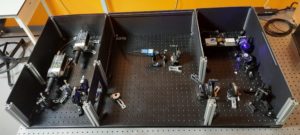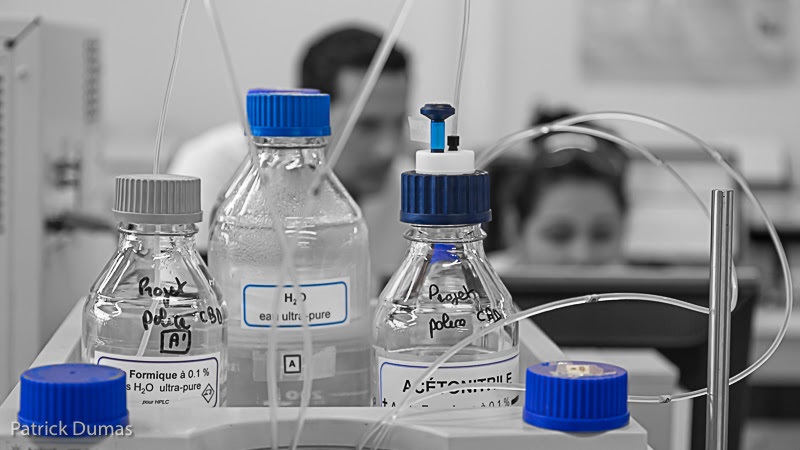Drones student project
M2 IDIM – Supervisors: H. Sabbah, N. Strehaiano, and P.Cafarelli
As a part of their second year of master degree, students organized in small teams of around 5 members work on an instrumentation and development project around drones. They tackle the various aspects of an engineering development mission. To help them we have acquired several drone platforms (bench platforms and ready to fly systems). All the equipment has been funded thanks to the NanoX project (graduate School of research) and is available at the University of Toulouse-Paul Sabatier (building 3TP1 room H5).
The drones bench platforms provide hands-on in back engineering and studies of various aspects of an embedded system including: simulations and validation of flight behavior, telemetry, data transmission, storage and processing, power generation and management, collecting data from on board sensors and building ground stations for control and data visualization in real time. We also have a test bench to carry out experimental studies on the behavior of a drone in different configurations to facilitate drone conception. This allows us to record the motor and propeller rotational speed, thrust and noise generated by the propeller, and electrical power consumed by the motors as well as battery discharge time.

Ready to fly drones are used as platforms to test developed scientific payloads to sense the environment in flight mode. Several projects have been accomplished. Some of them are:
- establishing radiofrequency telemetry using Lora technology between a drone and multiple ground stations,
- design of LabVIEW and Python-based ground stations for collecting and visualizing in real time data parameters like temperature, pressure, position (latitude and longitude), speed, distance, flight direction, altitude, flight time.
- design of a LabVIEW interface to animate, in real time, a pseudo 3D avatar of the flying drone.
FT-IR Spectrometer
 Licence (L3), Professional Licence (Lpro) and Master (M1 and M2) – Supervisor: C. Dinoi
Licence (L3), Professional Licence (Lpro) and Master (M1 and M2) – Supervisor: C. Dinoi
Thanks to NanoX funding (ca. 14 k€), the technological hall and the Spectroscopy pool of the Toulouse III, Paul Sabatier University have been equipped in 2020 of a FT-IR Spectrometer (PerkinElmer) containing a standard, high-performance, room-temperature LiTaO3 (lithium tantalate) MIR detector with a SNR of 9.300:1. The instrument displays a Standard optical system with KBr windows for data collection over a spectral range of 8.300 – 350 cm-1 at a best resolution of 0.5 cm-1 allowing the IR characterization of solid, liquid and gas phase samples.
320 students at the Licence (L3), Professional Licence (Lpro) and Master (M1 and M2) level are currently using this Spectrometer in organic, inorganic, analytical, green and bio chemistry classes.

Through this FT-IR Spectrometer, students may characterize the organic and inorganic compounds they synthetize during their practical classes, learning how to identify the nature of the different chemical bonds based on their IR absorption. This instrument is used in different application areas ranging from the characterization of chemicals and materials to the analysis of pharmaceutical, food and environmental products, allowing students to learn the basics of IR spectroscopy, to become familiar with the different IR sampling techniques, to analyze the measured IR spectra and to compare the analytical performance of this technique with other techniques such as UV-Vis and RMN.
X ray tomography
 4th year engineer students – supervisor: S. Cayez
4th year engineer students – supervisor: S. Cayez
 X ray tomography equipment is located at INSA Génie Physique département in TP4 service.
X ray tomography equipment is located at INSA Génie Physique département in TP4 service.
This equipment gives access to a wide field of physicals analysis (Electronic failure analysis, material science, mechanic…).
It is integrated to practical courses for non destructive test. Students can acquire a large set of X-ray images, proceed to the reconstruction, and then have an amazing 3D visualisation of electronic component or materials.
Capillary Electrophoresis
 Professional Licence (Lpro) and Master (M1 and M2) students – Supervisor: C. Dinoi
Professional Licence (Lpro) and Master (M1 and M2) students – Supervisor: C. Dinoi
Thanks to NanoX funding (ca. 35 k€), the technological hall and the Spectroscopy pool of the Toulouse III, Paul Sabatier University have been equipped in 2019 of a Capillary Electrophoresis (Agilent) containing an autosampler (50-positions carousel) and an UV-Visible diode-array detector (190-600 nm). The instrument is also provided with a high-speed forced–air cooler with Peltier element.
Students at the Professional Licence (Lpro) and Master (M1 and M2) level are currently using this instrument in organic, inorganic, analytical, green and bio chemistry classes.

Through the Capillary Electrophoresis, students may analyze and characterize the ion composition of the different samples prepared during their practical classes, learning how to separate ions based on their electrophoretic mobility with the use of an applied voltage. This instrument is used in different application areas such as the analysis of ions in beverages, honey, dairy products and pharmaceutical tablets, allowing students to understand the principles of capillary electrophoresis and to compare the analytical performance of this technique with other techniques such as LC and GC.
Automatic osmometers
 L3 Chimie, M1 Procédés Physico-Chimiques students – Supervisor: M. Gibilaro
L3 Chimie, M1 Procédés Physico-Chimiques students – Supervisor: M. Gibilaro

NanoX was essential to buy new automatic osmometers (Osmotouch1), located in 2TP2 building in the Chemical engineering and Thermodynamics practical lab, and used by licence and master-degree students (L3 Chimie, M1 Procédés Physico-Chimiques). It is based on freezing points measurements, a simple, fast and precise technique. From this value, thermodynamic properties of the solution are calculated (activities, activity coefficients…). For instance, the decrease of the solvent freezing point by solute addition or the solution colligative properties by salt addition can be demonstrated.
Bell inequalities violation
 students – Supervisor: B. Chalopin
students – Supervisor: B. Chalopin

